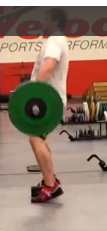http://youtu.be/hCd7qoqOoBo
A few weeks ago, Hook Grip posted up this video asking “why do you think Yuan Chengfei missed the jerk?”
Some of the answers I read kind of threw me off a bit. Especially those that had stated it was his torso lean. While yes this is technically true, the torso leaned caused a missed lift, it was a bit surprising that they weren’t asking the question: “why was there a torso lean?”
Understanding the Why
Typically, when you watch a failed lift at face value, you’ll see the compensation pattern. Things such as he leaned forward, jumped backward, went on the toes, and so on. While these examples are a component to a missed lift, it’s not the underlying factor. Understanding WHY the lifter leaned forward, hopped forward/backward, went on their toes etc… will better answer the mechanical failure and help address the weightlifters issue.
Where to Start
This a bit harder to explain online, as developing a coaching eye is more a practical aspect and I suck at conveying messages on paper. With that said, GENERALLY speaking you want to look at the base of support and then look out. This means to look at the first pull/set up in the clean/snatch and dip in the jerk, these are usually the issues for novice and intermediate lifters and then into the transition, 2nd pull, etc…
The Ripple Effect
http://youtu.be/8Doz0YD8zmw
For example, this video was asked to be critiqued. A majority of the responses stated that this weightlifter needs to focus on front squat strength. At face value it seems like the weightlifter could not handle the weight because of his lack of squat strength. However, from my point of view, the miss did not occur from strength but from the first pull and set up, which then turned into ripple effect through the full lift.

If you watch at the 11sec marker, as the weightlifter pulls he’s pitched forward and the bar is now set pretty far in front of his center of mass (COM), this then creates the ripple effect. By not having a consistent set up it throws off the first pull, throws off the transition, pulls the lifter forward during the double knee bend/2nd pull, and so on. Getting comfortable with a consistent set up and better positioned first pull should allow the bar to be tighter to the lifters COM. Which will create a positive ripple effect and set the weightlifter up to pull efficiently and catch the bar in a stronger position to squat the bar up.
And as stated earlier, building leg strength is key and potentially could’ve helped this weightlifter squat up the bar BUT it’s still does not address the pull issue which. Ignoring a key aspect of the lift WILL catch up to the weightlifter soon enough and can mentally mess with the weightlifter. We’ll have to talk about this another time, just know that a balanced foundation of technique and strength, depending on the lifter, is generally a solid philosophy to work off of.
To conclude, my advice is to not always look at the lift at face value and not to just assume that strength is the issue. While sometimes strength could be the culprit, just know that strength isn’t the cure for every missed lift.
Train smart,

